-
1. g3
Reti was one of the revolutionaries of the "Hyper-Modern" era of chess. The old school of chess believed that success could only come through occupying the center, while the "hyper-modernist" insisted that it was ok to allow a big center so long as one could attack it from the flanks later.
Today the normal move order to reach the Reti Opening is to play: 1.Nf3
Now MCO gives the line: 1...d5 2.c4 c6 3.b3 Nf6
1...e5
Seizing the center
2. Nf3!?
"An experiment which Reti never repeated after the present game. White intends to play an "Alekhine's Defense" with colours reversed, i.e. with one more tempo. But the way he uses the tempo (g3) could have turned out to his dis-advantage" (see next note) - GM Alekhine.
2...e4
3. Nd4 d5
"Black is satisfied with the free development of his pieces and rougly equal middlegame prospects but he could obtain more with 3...c5! 4.Nb3 c4 5.Nd4 Bc5 6.c3 Nc6! thus bringing "ad absurdum" White's development" - GM Alekhine.
4. d3
Definitely not: 4.Nc3?? c5 5.Ndb5 a6 6.Na3 b5! 7.Nab1 d4 8.Nxe4 f5 and black is clearly better.
4...exd3?!
Black almost completely surrenders the center for no real reason. Better was 4...Nf6! - GM J. Nunn.
5. Qxd3?!
GM Seirawan considers this move too provactive and gives 5. cxd3 brining a flank pawn to the center as better.
5...Nf6
6. Bg2
Logical development by both players.
6...Bb4+?!
"Trying at all costs to bring as rapidly as possible all blacks pieces into action. But nowadays I would probably have thought more about the security of the dark squares in my position and would therefore have avoided the following bishop exchange."--GM Alekhine.
7. Bd2
7...Bxd2+
Black must go through with the trade now or lose a tempo.
8. Nxd2,
To take with the White Queen is to agree to a loss of tempo.
8...0-0
Black has moved his King to safety and is ready to make use of the half-open e-file. Next he must find good squares for his Q-side pieces.
9. c4!?
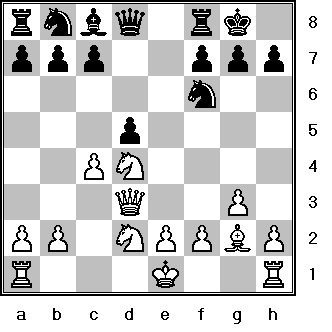
"This (and 4. d3, exd3) fits in perfectly with Reti's philosophy of allowing the enemy to establish a pawn center and then attack it. But Black's acquiring of d5 recalls Aaron Nimzovich's own version of Hypermodernism --- that you can occupy the center in order to liquidate the pawns and create outposts on the vacated squares." - GM Soltis.
9...Na6
"The best defence" - GM J. Nunn. Black obviously intends ...Nc5 or ...Nb4 winning a tempo off of the White Queen. The continuation: 9...c5? 10.N4b3 dxc4 11.Qxc4 would just lose a pawn.
10. cxd5 Nb4
11. Qc4 Nbxd5
12. N2b3
"Securing the Knight on d4." - GM J. Nunn.
12...c6
"Aiming to retain Black's main asset, the strongly posted Knight on d5." - GM J. Nunn.
13. 0-0 Re8
"Black has excellent development and can discourage the most dangerous White plan of e2-e4." - GM Soltis.
14. Rfd1
Mobilization and Centralization are the keys to strategic success according to GM McDonald.
14...Bg4
"Aiming for counterplay against e2." - GM J. Nunn.
"To prevent e4." - GM R. Fine.
15. Rd2
"After 15. h3 black would have moved his bishop to e4 via h5 and g6"- GM Alekhine
15...Qc8!?
To prevent h3 and possibly exhcnage whites fianchetto defender with ...Bh3 and ...Bxg2
16. Nc5
"Clearing the way for the b-pawn's advance." - GM J. Nunn.
16...Bh3!
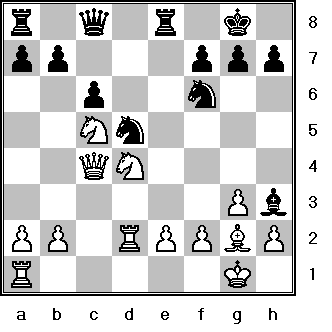
Black offers a pawn sacrifice which cannot be accepted: 17.Bxh3? 17...Qxh3 18.Nxb7? Ng4 19.Nf3 Nde3! 20.fxe3 Nxe3 (threatening 21...Qg2#) 21.Qxf7+! Kh8! 22.Nh4 Rf8 would cost him his Queen. Now the game has reached a critical point. The game should probably end in a draw after 17. Bf3 Bg4 18. Bg2 Bh3 etc.
17. Bf3 Bg4
18. Bg2 Bh3
19. Bf3 Bg4
"Here Alekhine erroneously claimed a draw by recurrence of position. The position has occured only twice, and even if it had occurred three times, black could not claim the draw because a draw by recurrence can only be made by the one whose turn it is to move. With 20. Bg2 white could have claimed successfully. Having a slight superiority Reti decides to evade the draw. Not, of course by allowing the exchange of his fianchettoed bishop, as that would seriously weaken his white squares. Alekhine may have made the absurd draw claim deliberately, to make Reti over-confident (Purdy)." - Irving Chernev.
20. Bh1!?
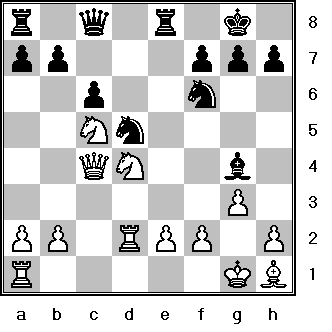
Reti decides to play for a win.
"White controls the half-open c-file on the queenside. If he could open it completely and occupy it with his heavy pieces it would give him a clear advantage. Whites plan is clear, he will play for a minority attack on the queenside by b2-b4-b5 and if ...a6 then a4 will support the advance.
Black on the other hand plans to attack on the other wing. He intends to weaken the position of the white king with the idea of h7-h5-h4-hxg3 in order to reduce the number of pawns sheltering the white king. However even after achieving this goal it is not clear how he will benefit from it." -Analysis by GM's Alburt and Palatnik.
20...h5!
21. b4
If 21.e4!? Nb6 22.Qc3 Qc7 23.b4 Nbd7! "and Black eliminates the powerful c5-knight." - GM J. Nunn.
"21. e4 limits the bishop on h1 and doesnt give white anything real."--GM's Alburt and Palatnik
21...a6
22. Rc1
"Necessary. After 22. a4 White could not immediately continue with b4-b5 because the a1 rook would be unprotected" --GM's Alburt and Palatnik.
22...h4
23. a4 hxg3
24. hxg3 Qc7
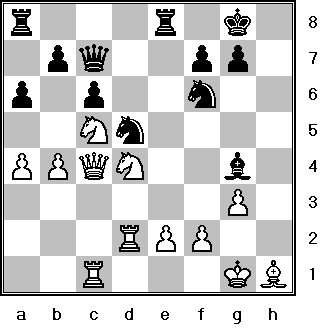
"Reti, playing with ongoing inventiveness, has managed to retain the initiative. He has a positional edge because of his superiority in the centre and on the queenside, with Alekhine obviously looking for counter chances on the kingside." - GM Garry Kasparov.
"Black has targeted the g3 pawn as the weak point so he aims his Queen at it and prepares to mow it down."--GM Seirawan.
25. b5!?
White could have played: 25.e4!? Nb6; GM G. Kasparov calls: " 25...Ne7!? 26.a5 a solid positional alternative." GM J. Nunn then considers the position about equal.
"The pawn protection of the White King has been slightly weakened, but black has no specific threats right now and it looks like he cannot even dream about making a successful attack. Thus, white only pays attention to his own plan. But in retrospect, we should say that 24. e4 was better."
25...axb5
Not 25...Qb6?! 26.bxc6 "White is clearly better."
26. axb5
"White's strategy seems to be working very nicely. The isolated black pawn is doomed to fall within a few moves. But Alekhine wasn't going to passively wait for destruction. He finds a way to completely change the unwanted course of the game." - GM Garry Kasparov.
26...Re3!
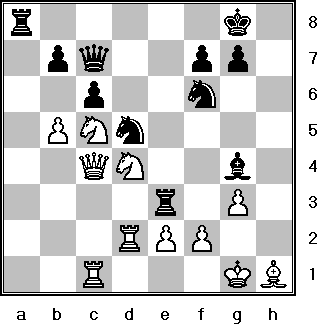
"Black trains his guns on the weakened g3 pawn"- GM Seirawan
If now 27. exf3??, Qxg3+ followed by 28...Nxe3 and wins. Also white has to parry the threat of ...Rxg3+! -Alekhine
"Just as White's Queenside attack arrives, this spectacular rook sacrifice energizes Black's counterplay." - GM J. Nunn.
"Startling, to stay the least." - Irving Chernev.
27. Nf3?
Both Nunn and Kasparov give a question mark here.
After VERY SHARPLY criticizing White's 27th move, GM John Nunn said, "In my opinion this does not detract from Alekhine's achievement. When playing at his best, Alekhine had a special ability to provoke complications without taking excessive risks."
Virtually all the computer chess programs change significantly in Black's favor after White's twenty- seventh move.
This is the losing move. However it must be said that while sitting at the board this looked like a perfectly playable and natural continuation to Reti. It must have been quite a task to try to calculate all the consequences of the extreme tactical nature of the position.
"This is the critical moment of the game." - GM J. Nunn.
**********************************************************************************
Extensive computer analysis by Life Master AJ Goldsby has now shown that white is winning had he instead played:
27.Kh2!
Blacks attack while extremely complicated was unsound. Even so it offered practical winning chances at the board.
This move was already considered the best line According to Alekhine.
27...Raa3
This was given by Alekhine in his book on his best games as his intention. This is also best according to Nunn.
28.Nd3!
And now:
The critical line, worked out by John Nunn is: 28...Nh5!
If plays: 28...Rxg3? then 29.fxg3 Nh5 30.Rg1 Ne3 31.Qc1 Rc3 32.Qe1 "wins for White." - GM J. Nunn. Or 28...Ne4?! 29.Bxe4 Rxe4 30.Qxd5 cxd5 31.Rxc7 Rxd4 32.Rxb7 Bxe2 33.Rxe2 Raxd3 34.Rb8+ Kh7 and now: 35.Re7 "gives White a very favorable ending." - GM J. Nunn. ).
29.Qxd5! Best
29...Nxg3 Forced
( Not 29...Rxg3? 30.Qe5!, "+/-" - GM J. Nunn. ).
30.Kg1 Nxe2+
Not 30...Qa5?! 31.bxc6! Qxd2 32.cxb7! Re8 33.Rb1! Rxd3 34.b8Q Qd1+ 35.Rxd1 Rxd1+ 36.Kg2 Rxb8 37.Kxg3 Bxe2 38.Qe5 Rd8 39.Nf5 "wins for White." - GM J. Nunn.
31.Nxe2 Rxe2
Now most analaysts here give 32.Qc5!? with the following commentary, "when White is slightly better, but does not have real winning chances." - FM G. Burgess. GM J. Nunn, in the book, "The World's Greatest Chess Games," gives many lines, but ends with this crucial one, and concludes that the game should be drawn.)
However research by Master Goldsby has shown:
32.bxc6!!
32...bxc6
(Or 32...Rxd2?!; 33.cxb7! winning. eg. 33...Qb8 34.Rc8+! Bxc8; 35.Qd8+ Kh7; 36.Be4+! f5; 37.Qh4+! Kg8; 38.Bd5+! Be6; 39.Bxe6+ Kf8; 40.Qh8+ Ke7; 41.Qxb8 This is of course an easy win for White! (I extended this line to it's logical conclusion because many students could not follow it -AJ Goldsby)
33.Rxe2 Bxe2; 34.Qe5
Over an hour's worth of analysis, and checks of 3 different strong computer chess analysis engines confirms this is a win for White! (A BIG hole in Nunn's work!).
This refutes Alekhine's entire concept, ... and his whole combination!!! -AJ
I (AJ) sent this whole analysis to GM A. Soltis during the time period of Oct.-Dec, 2001. I waited several months, and this was his exact reply:
"Dear A.J.,
Your analysis looks good to me. Maybe no one considered the the line: 32. bxc6 (!) before, because they didn't see 32...Rxd2 33.cxb7, Qb8 34. Rc8+!"
"As to what this means for the game, I'm not sure. Maybe Black isn't so badly off after 28...Bh5; after all." (Soltis is basically agreeing here with what I said in my analysis, and my letter to him-AJ)
"I'm surprised you found so many Nunn errors. I never use a computer to verify my analysis, but I assumed that he did."
"Good work!!"
Sincerely, GM Andy Soltis. (No date on the note, but the letter's envelope was post-marked, February 13, 2002.)
So it seems that black must play 28...Bh5!? given as best by several strong computer programs: 29. Bxd5 when white is clearly a little better.
All the analytical work in this section was done by Life Master AJ Goldsby
***********************************************************************************
Now back to the actual game:
27...cxb5!
Black isolates his b-pawn, but blows the game wide open.
28. Qxb5 Nc3!
"A second critical phase of the combination. White's e-pawn falls." - GM A. Soltis.
"The fireworks continue." - Irving Chernev.
29. Qxb7
[ 29.Qc4!? b5 "and the (white) Queen cannot continue to defend e2." - GM John Nunn. Or 29.Qb2?! Ra2 " and "Black is clearly better." ].
29...Qxb7!
30. Nxb7 Nxe2+
31. Kh2
"A fantastic position, so much is en prise. Yet the material is even, and one would ordinarily expect a quick draw. But Alekhine has a trick up his sleeve: he will win White's QN at b7 after twelve (12) forced moves!" - GM R. Fine.
Not 31.Kf1 Nxg3+! 32.fxg3 Bxf3 33.Bxf3 Rxf3+ 34.Kg2, (Or 34.Ke2 Rxg3). 34...Raa3 35.Rd8+ Kh7 36.Rh1+ Kg6 37.Rh3 Rfb3! "White must give up the Knight or be mated in two moves by the Black Rooks." - Irving Chernev. (a linear mate on 7th and 8th ranks)
31...Ne4!!
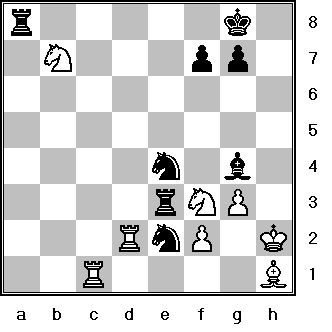
"Just when you think the combination must be over ... - because of the absence of Queens - Alekhine continues to find tactics." - GM Soltis.
One of the greatest queenless attacks of all time. '!!' - GM Kasparov.
32. Rc4
"A superior defense was: 32.Rd8+! Rxd8 33.fxe3, was best from a pragmatic point of view. It would force Black to find the difficult 33...Rd5! 34.Rc4 N2xg3 after which 35.Bg2 Nf1+! (and) wins." - GM A. Soltis. Continuing this line, we get: 36.Kg1 Rd1; 37.Bxf1 Bxf3 and "the threat of 38...Nd2 is decisive." - FM G. Burgess and GM John Nunn.)
32...Nxf2!
33. Bg2
"This avoids the Black threat of Nxh1 and then Bxf3+." - Irving Chernev.
White could have also played: 33.Ng5!? Nxh1 (33. Nd6'?! 33...Be6 black is winning) Or 33.Rcc2 Nxh1 34.Rxe2, ( Or 34.Kxh1? Bxf3+ and now play could proceed: 35.Kh2 Ra1! The threat of ...Rh1 mate is decisive 34...Rxe2+ 35.Rxe2 Bxf3 wins.
33...Be6!
"Black clears g4 for 34...Ng4+; 35. Kh1, Ra1+." - GM Soltis.
"Gains a decisive tempo." - Irving Chernev.
"The remaining moves are all now forced." - GM John Nunn.
34. Rcc2 Ng4+
35. Kh3
"Forced, for if 35. Kh1, Ra1+." - GM Fine.
35...Ne5+
36. Kh2
Unfortunately for White, this looks forced. 36.Kh4? Ra4+ and Black wins.
36...Rxf3!
Yet one more beautiful tactical shot by Alekhine.
37. Rxe2,
Forced again.
If 37.Bxf3? Nxf3+; 38.Kg2 Nxd2 black wins - Irving Chernev. ].
37...Ng4+
This forces White to walk into a discovered check.
38. Kh3 Ne3+
39. Kh2 Nxc2
40. Bxf3
And this is forced too.
It also looks like White has (nearly) escaped. If 40.Rxc2? Re3 and black wins.
40...Nd4!
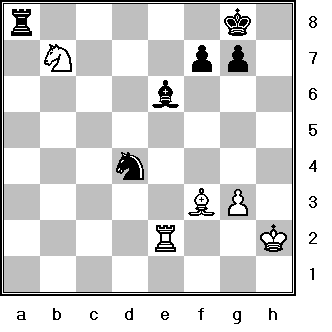
White Resigns
0 - 1.
White loses a piece after: 40...Nd4!; 41.Rf2 Nxf3+; 42.Rxf3 Bd5!
Tactical Themes: Alekhines block-disruption, line opening, demolition, double attack, enticement, fork
Mating Themes: Linear mate